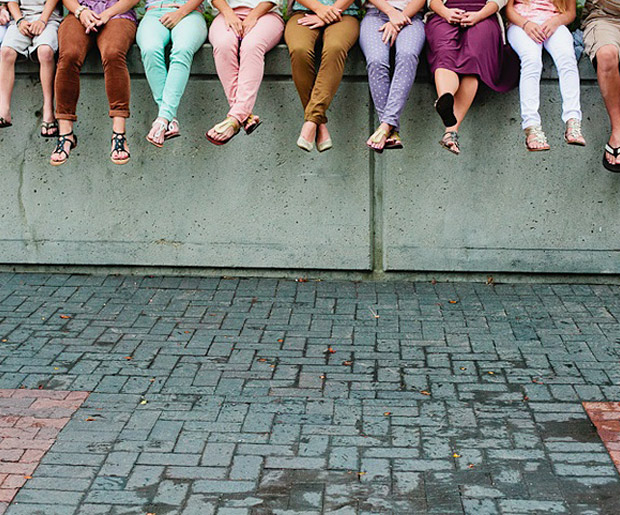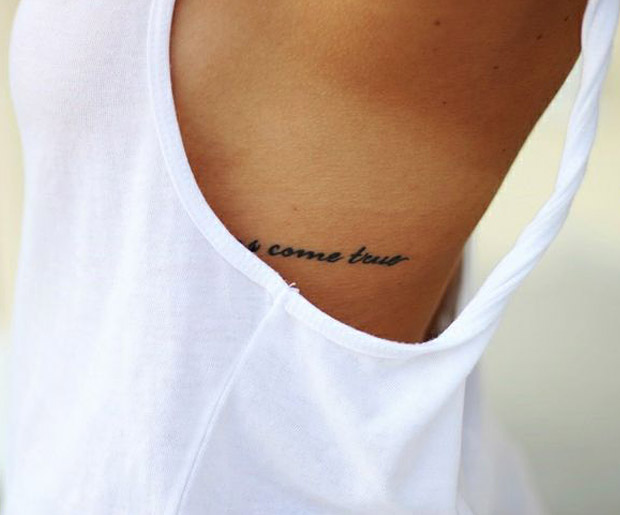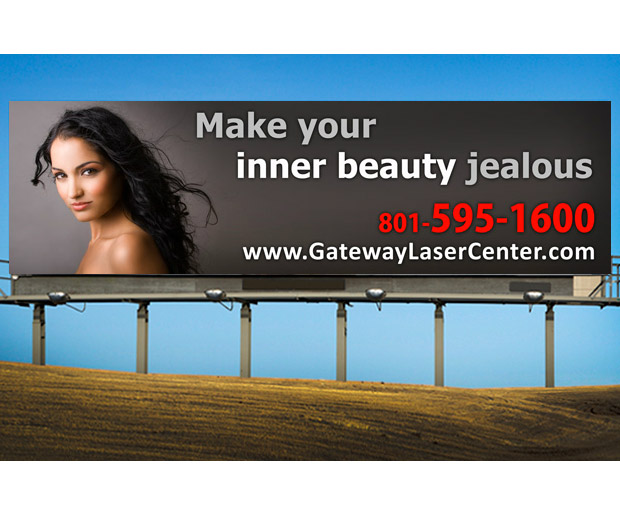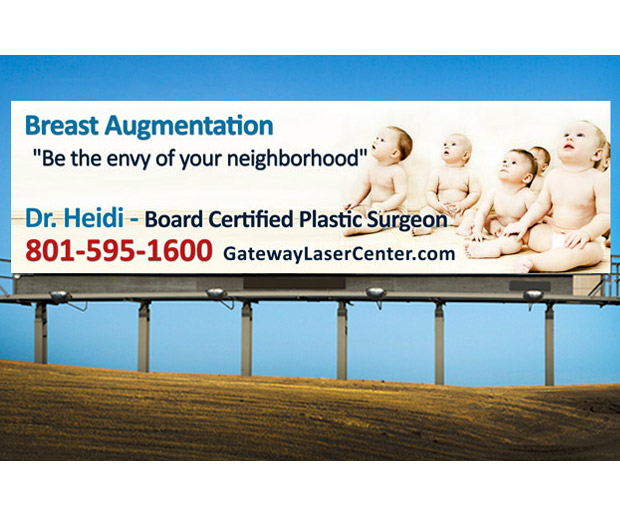What do you think of when you hear the term "boob job"? Inflated, oversize breasts? New divorcees flaunting perkier chests? Beverly Hills housewives? Whatever your answer, it's probably not Mormons. That is, unless you happen to have driven down Interstate 15, the highway that passes through the so-called "Mormon corridor" in Utah, named for its path through some of the most populated Mormon areas. Billboards advertising plastic surgery are "everywhere," according to residents.
"At least half of the billboards have to do with teeth whitening, Lasik surgery, cellulite reduction or any sort of plastic surgery," says one Utah resident. "It's pretty crazy. People comment on it all the time."
And it seems like billboard advertising
is effective, at least in this case. According to a study released by
RealSelf, residents of ultra-conservative, ultra-religious Utah definitely have plastic surgery on the brain -- and, well, the boobs. The state is responsible for the highest number of Web searches for breast augmentation procedures, beating out more obvious locations like California and Florida. Surprised by this statistic? It's not the first time Utah's plastic surgery prevalence has been documented. In 2007, the mostly Mormon state (over 60 percent of the overall population is Mormon, with over 80 percent documented in some counties) made headlines when
Forbes named Salt Lake City America's Vainest City, because of the high number of plastic surgeons per capita.
The data begs the question: Why are so many Mormons getting boob jobs?
Julie de Azevedo Hanks, licensed psychotherapist and founder and executive director of Wasatch Family Therapy, is a Mormon with more than 20 years of experience counseling women in Utah. She says that it's the grouping of like-minded people that may contribute to Utah's high plastic surgery rate.
"There are things about Utah that are unique, and I think those things happen when you get a large, homogenous group together, living together for a long time."
Nineteen-year-old Utah resident and ex-Mormon Elizabeth Folsom*, who left the church about two years ago, agrees, linking the high instance of plastic surgery among Utah residents to a culture that she says is driven by perfectionism.
"The Mormons in Utah are surrounded by other Mormons. They aren't automatically 'better' than their neighbors, because their neighbors are Latter Day Saints (LDS), too," says Folsom. Her stepfather, a bishopric (translation for non-Mormons: "head honcho") of his ward, bought her mother two breast augmentations over the course of their 13-year marriage. He also gifted his new wife, whom he married a few years after their divorce, with breast implants. She says that Mormons in Utah turn to external methods (e.g. plastic surgery) to feel that they are fulfilling their potential for perfection, a goal that de Azevedo Hanks says may be derived from scripture but is misconstrued socially.
"There are some Mormon doctrine issues that come into play that I think are misunderstood," says de Azevedo Hanks. She's referring to an oft-cited passage from the Bible's New Testament,
Matthew 5:48, which reads, "Be perfect, therefore, as your heavenly Father is perfect."
"I hear people talk about that [passage], and say, 'Well, I should be perfect.' I think because of the society we live in that is so externally focused and beauty-focused, that the scripture, which is not really about being externally flawless, gets misinterpreted in the context of our culture of youth and beauty obsession," says de Azevedo Hanks.
It's a sentiment echoed by 33-year-old Mormon mother-of-two Amy Smith*, who had a breast augmentation at 18 and liposuction a few years later.
"There is this weird thing in Utah," says Smith, who lives in Utah but formerly resided in Los Angeles. "In Los Angeles, people accept you for who you are and being different is valued, but here it's very 'keeping up with the Joneses.' You have to try to be perfect, everyone is kind of cookie-cutter and everyone looks the same. I think that the [popularity of] plastic surgery has to do with the image of being perfect. That's very big in Mormon culture. If you're different, you're kind of ostracized."
Smith, who says her mother and brother have also had plastic surgery, admits that it seems odd that her whole family has had it. "We're not weird, we're not crazy," she rushes to explain. "When I say it like that it sounds crazy, but it's just the normal thing to do here. Is that weird?"
The statistics are especially puzzling because of the stance the Mormon church has taken on altering one's body. According to the official LDS website, Mormons are instructed, "You would not paint a temple with dark pictures or symbols or graffiti or even initials. Do not do so with your body." The church took an official stance against
piercings and tattoos a few years ago.
Gretta Whalen -- an LDS member, former Utah resident and daughter to the director of the breast care center at Salt Lake Regional Medical Center -- says that the double standard was puzzling in her youth. "Growing up, I knew that there were women in my congregation who had their breasts done. But I also knew that if someone had a tattoo, a visible, obviously defiant behavior, that that was unacceptable. Yet plastic surgery was OK."
Like de Azevedo Hanks, Whalen cites the culture of perfectionism as one of the potential reasons behind the prevalence of breast augmentations in Utah.
"[Mormons] believe that they're kind of chosen and exceptional," says Whalen. "And not in a way that puts other people down, but just in a way that makes them feel very blessed. They feel very lucky to be born into the church. They believe where much is given, much is expected and much is required. And that translates to every single aspect of life."
With so many Mormons interested in breast augmentations, why is it that the general population associates them with door-to-door Bible pushing, shirts under sundresses and football-league-sized families rather than a people in pursuit of perky breasts?
Smith suggests it's because plastic surgery is very hush-hush in Utah. "[Plastic surgeries are] kept secret. People have this image of being perfect, and if you tell them you got boobs to make you perfect, that makes you less perfect. [Plastic surgery] happens, and everyone does it, but, no, we don't really talk about it."
Whalen says that those who get their breasts augmented don't volunteer the information, perhaps because of an unspoken pressure to look beautiful without really trying. "Mormon women hold themselves to a higher standard of
natural beauty," she emphasizes. "If they do invest in their looks, they don't talk about it -- like if they get laser hair removal, or if they're not naturally blonde anymore. It kind of feels like the '50s sometimes."
In other words, Utah's Mormons are expected to be able to take a flawless #wokeuplikethis selfie at any given time.
Where does this seemingly unattainable standard come from? Whalen says it's a mixture of sources.
"You don't know where the pressure is coming from or who's putting it on, but you know it's there. You don't know if it's the church, society or both."
Plastic surgeon Renalto Saltz, who has two practices in Utah, points to a few other statistics in order to explain Utah's interest in bigger bosoms.
"One of the factors is you have families here that have kids very, very young," says Saltz. "When we see these women in their late 20s, their anatomy has already been really damaged by multiple pregnancies."
Mormons are encouraged to get married very young and have children almost immediately. Like Adam and Eve, church members are told to multiply and replenish the earth -- which leaves them with a brood of children and a body that, while still relatively young, is unrecognizable to them.
"These girls go from basically being teenagers to having three, four, five kids by the time they're 30," says Whalen. "Having children in a short amount of time really changes your body, and all they want is to have what they had before. It's a restorative process."
Utah also has the highest birth rate and the highest number of children per family in the U.S., which de Azevedo Hanks says contributes to the plastic surgery numbers. She says her clients feel they have sacrificed their body for their families, and they see the "mommy makeover" they get after having children as a gift to themselves. "They're trying to get back some of what they've given up," she explains. She also says that looking good may be a way young mothers seek to redeem themselves. "When you're marrying young, there's a tendency to give up other parts of your life -- talent development, education or whatever -- and so you may turn to external things to get a sense of self-worth," she says.
Smith, whose implants are 15 years old, says that she'll definitely get another boob job after she's done having children. "You're supposed to get them redone after 10 years. I'm already planning on it."
*
Names have been changed.







